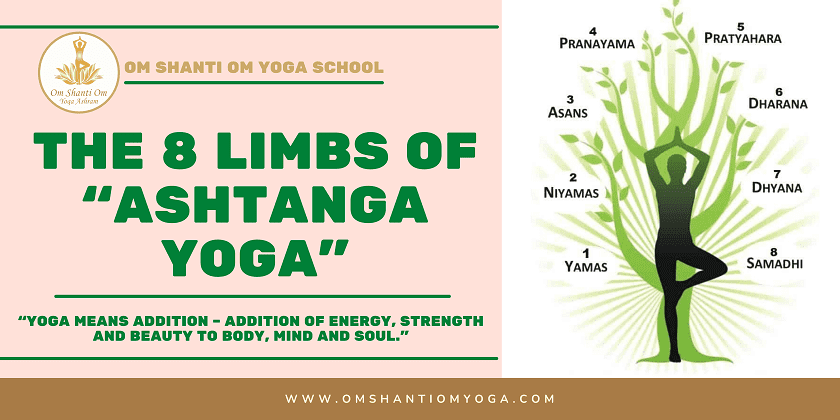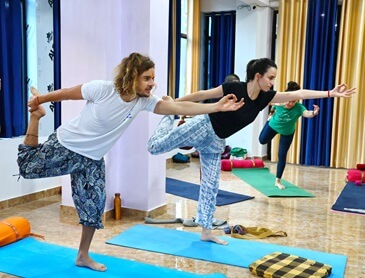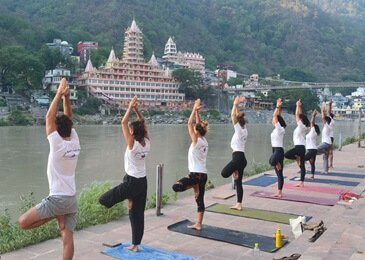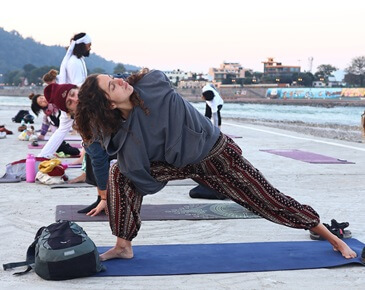
11 Feb. 2022
THE 8 LIMBS OF “ASHTANGA YOGA”
The eight steps of ASHTANGA YOGA This is the whole science of yoga in one sentence, in one seed. Many things are implied. First, understand the exact meaning of each step. And remember, Patanjali calls them steps and limbs - both. They are both. They are steps because one has to be followed by the other, there is a sequence of growth. But they are not only steps: they are limbs of the body of yoga. They have internal unity, as well as an organic unity, that is the meaning of limbs. For example, my hands, my feet, my heart - they don’t function separately. They are not separate; they are an organic unity. If the heart stops, the hand will not move then. Everything is joined together. They are not just like steps on a ladder, because every rung on the ladder is separate. If one rung is broken the whole ladder is not broken.
So Patanjali says they are steps because they have a certain, sequential growth - but they are also Angas. Limbs of a body, organic. You cannot drop any of them. Steps can be dropped; limbs cannot be dropped. You can jump two steps in one jump, you can drop one step, but limbs cannot be dropped; they are not mechanical parts. You cannot remove them. They make you. They belong to the whole; they are not separate.
The whole functions through them as a harmonious unit. So these eight limbs of yoga are steps in the sense that each follows the other, and they are in a deep relationship. The second cannot come before the first - the first has to be first and the second has to be second; the eighth will come to be the eighth - it cannot be the fourth, it cannot be the first. So they are steps and an organic unity too.
The Patanjali Yoga Sutra is referred to as `yoga darsana`. The word ‘darsana’ means ‘seen’. So the philosophy of yoga is meant to be seen or to be experienced. The Sutras present not only the philosophy and science of yoga but the actual practice, through which the ultimate goal of yoga – kaivalya (detachment) - is attained.
The Yamas & Niyamas
The mind and body are closely connected to each other. Modern science has come to the conclusion that most diseases are nothing but a physical manifestation of the disturbances on the mental and emotional planes. In other words, physical health is dependent on mental well-being. In order to achieve a balanced state of mind, the observance of Yamas and Niyamas is necessary.
If the mind is disturbed and restless, the resulting physical disturbances can’t be combated by any of the asanas, that’s why it is essential to practice the Yamas and Niyamas.
YAMA OR SELF RESTRAINT
YAMA OR SELF RESTRAINT (Principles or moral codes or a set of universal moral commandments) The Yamas are five self-restraint or behavior patterns of relationships between the individual and the outside world. `Yama` means `control`, not suppression. Through understanding comes control. It is all about creating a friendly atmosphere around you. Yama is the bridge between you and society. It is a more conscious behavior: you don’t react unconsciously; you don’t react like a mechanism, like a robot. You become more conscious; you become more alert. You react only when there is an absolute necessity; even then that reaction should be a response and not a reaction. The Yoga Sutras of Patanjali 2.0 states these five commandments: ‘Ahimsa Satya Asteya Brahmacharya Aparigraha Yamaha’.
Ahimsa - The word `ahimsa` literally means ‘non-violence’; not to injure or show cruelty to any creature or person in any way whatsoever. Ahimsa is, however, more than just a lack of violence as adapted in yoga. It means kindness, friendliness, and thoughtful consideration of other people and things. It also has to do with our duties and responsibilities. It could even mean that we must fight if our life is in danger. Ahimsa implies that in every situation we should adopt a considerate attitude. The cultivation of ahimsa leads to a feeling of love and friendship to everybody. One begins to see the unity in all creation and thus progress towards the goal of self- realization.
Satya - `Satya` means ‘to speak the truth’, yet it is not always desirable to speak the truth on all occasions, for it could harm someone unnecessarily. We have to consider what we say, how we say it, and in what way it could affect others. If speaking the truth has negative consequences for another, then it is better to say nothing. Satya should never come into conflict with our efforts to behave with ahimsa.
Asteya - `Asteya` or `non-stealing` includes refraining from misappropriation, accepting bribes, and the like. The desire for what another owns can be very strong. Such an attitude leads to a feeling that ‘someone else has what I need in order to feel complete’. But stealing an external object doesn’t get rid of the basic sense of inadequacy, so one takes again and again. Still, the underlying feelings remain unsatisfied. Cultivating Asteya counteracts such attitudes. It helps to develop a sense of completeness and self-sufficiency and leads to freedom from the bondage of such cravings.
Brahmacarya – This literally means ‘to walk in Brahman’. One who cultivates this Yama is aware of Brahman alone. Such a state is possible only if the mind is free from all sensual desires. The sexual urge is the most powerful and the most destructive of all sensual desires. Brahmacarya is therefore often translated as abstinence from sex, or celibacy. Brahmacarya should not, however, be interpreted as repression of sexual urges - repression only leads to frustration and an abnormal state of mind. Brahmacarya means control of and freedom from sexual cravings. The bliss that accompanies self-realization is far greater than any sensual pleasure.
Aparigraha - Non-possessiveness. This has been misinterpreted to mean denying oneself of all material possessions. The problem arises when one gets addicted and dependent on material objects. By practicing the Yama of aparigraha (non-possessiveness) to the level of perfection, the Sadhaka (practitioner) realizes that a life without the support of worldly comforts, possessions, status, wealth, etc. is more helpful for his spiritual upliftment. And the yogi understands the futility of amassing material possessions. The sadhana realizes that possession of worldly goods, which all human beings are hankering after, is not the real purpose of human existence. He will enjoy all comfort with a non-attached attitude.
NIYAMAS
NIYAMAS (Fixed observance, regularity, self-purification) Patanjali’s Yoga Sutra 2.32 states the five ethical guidelines of how to be in peace with ourselves: ‘Sauce Sentosa Tapah Svadhyaya is Varapranidhanani Niyamam’. The five components of Niyama should be practiced for purifying the physical and mental bodies. `Niyam` means `fixed observance`, `regularity`. Now with the Yamas, you have related to society in a new way. Niyama is for the body. A controlled body is a beautiful phenomenon - controlled energy, glowing, always having more than what is needed, always alive, never dull, and dead. Then the body also becomes intelligent, the body also becomes wise, the body glows with a new awareness.
Sauca – Purity, the act of cleansing, and purification. In Yoga Shashtra (yogic scriptures) the word ‘Sauch’ denotes a very wide concept. Here ‘Sauca’ means external and internal purification. That is the purification of the soul as well as of the gross physical body. We know different ways to purify our bodies externally and to some extent internally. But to purify the inner self, the adoption of some moral virtues is required. In fact, internal purity is of greater value than external. Though external purification gives a feeling of peace and purity and creates an ambiance of the sacrament, it is of no use if internal purity remains unachieved.
According to Yoga Shastra, there are different ways for outer purification, such as Shatkarma (the six Yogic Kriyas: Dhauti, Basti, Neti, Lauliki [Nauli], Tratak and Kapalabhati).
Santosa – Contentment: to be contented and happy towards every situation in life is the basic meaning of Santosa. The mind should not be overloaded with demands and aspirations, which ultimately brings dejection and frustration. Complacence in true sense can only bring the serenity of mind, which is a vital requirement of yogic performances.
Tapas – Tapas has often been interpreted as excessive austerity, but it means simplicity. Being simple in your life is a great tapas. You are doing things from authenticity for your inner growth, not to show off. There is no desire to become extraordinary. I am what I am, as long as I am certain my way is not hurting others either physically or mentally – that is tapas.
Svadhyaya - Self-Study - study yourself. Who are you? What is inside? How this body is working? Who am I inside? This study will give you the way to look inside of you and gain a clear picture of who you are, what your true nature is, what you want, etc. You will be clearer about yourself. When your consciousness is clear, your mind cannot create conflicts for you. Then you can move towards your aim with clarity. You will be nearer to yourself. The self is the main aim here.
Ishvara Pranidhana - Dedication, complete surrender to God. This is the final stage of Niyama where, as stated in Yoga Darshan, lies the practice of surrendering oneself absolutely to God. At this stage, the yogi has to give up all sorts of desires and passions and must develop qualities like tolerance, love for all, and selflessness. Everything should be performed impersonally. An unconditional and absolute faith towards God in every thought and action is the essence of this stage.
The Benefits of practicing the Yamas and Niyamas:
The Yamas and Niyamas help in managing our energy in an integrative manner, complementing our outer life with our inner development. They help us view ourselves with compassion and awareness. They help us in respecting the values of this life, in balancing our inner growth with outer restraint. In short, they help us to lead a conscious life. Yamas and Niyamas are not about right and wrong. They are about being honest with the true Self. Living according to these principles is about living our lives in a better way, about moving towards an understanding, about making it possible to ‘connect’ with the Divine.
ASANA (Posture)
ASANA (Posture) Patanjali’s Yoga Sutra 2.46 states, ‘Sthira Sukham Asanam’, which means Asana should be a steady and comfortable posture. Whatever Asana is performed, it should be done with a feeling of steadiness, awareness, and delight. The practice of Asana heightens one’s awareness and prepares one for one-pointedness which is essential for Dharana (concentration).
PRANAYAMA (Breath-control)
PRANAYAMA (Breath-control) Patanjali’s Yoga Sutra 2.49 states, ‘Tasmin Sati Svasa Prasvasayoh Gativicchedah Pranayamah’ which defines Pranayama as the regulation of in-breath and out-breath with retention. It is important to note that Patanjali expressly advises the practitioner to practice Pranayama only after attaining perfection in Asana. The breath is our life. It is very important to know this. The practice of Pranayama prepares the mind for Pratyahara.
PRATYAHARA (Withdrawal of Senses)
PRATYAHARA (Withdrawal of Senses) Pratyahara is the fifth Anga of Patanjali’s Astanga yoga. The specific meaning of the term Pratyahara in ashtanga yoga is ‘the withdrawal of the senses inwards towards their source’ viz. Pratyahara means you are with your true self, you are turning inwards, listening to what`s inside you. You are returning to your home. All your senses are helping you to move inwards.
The five sense organs and their functions are as follows:
The eyes like to see ii) The nose likes to smell iii) The tongue likes to taste iv) The ears like to hear melodious sounds v) The skin likes a tender touch
Though these are the blessings for fully living life, they bring with them vices which are called SEX, ANGER, GREED, ILLUSION, PRIDE, and JEALOUSY. Since the organs are the centers of perception and sensation, having control over the organs keeps the mind free from all these unnecessary disturbances.
DHARANA (Concentration, Focus)
DHARANA (Concentration, Focus) Patanjali’s Yoga Sutra 3.1 states that Dharana is the stage of concentration whereby one gathers the scattered mind in one place and gets it to concentrate on a certain object. Dharana occurs when the Chitta or the mind-stuff is confined and limited to a certain place or object.
According to Yoga Shasta, sixteen places in the human body that are suitable for concentration have been identified. This is known as “SHORHOSH BANDHA ADHAR” as described in the third chapter of the Hatha Yoga Pradipika. They are: 1) Padangustha (Big Toes), 2) Padagulpha (Heels), 3) Gujjhadesh (Anus), 4) Lingamul (Genital organs) 5) Navimandal (Naval), 6) Hridaya (Heart), 7) Kanthakup (Throat cavity), 8) Jehwagra (Tip of the tongue), 9) Dantadhar (Teeth), 10) Talumul (Root of the palate), 11) Nasagra (Tip of the nose), 12) Bhrumadhya (Middle point of the eyebrows), 13) Netradhar (Eyes), 14) Lalat (Forehead), 15) Murdhna (Medulla Oblongata), and 16) Sahashrara (seat of the soul).
DHYANA (Meditation)
DHYANA (Meditation) Dhyana is a technique for attaining a state of consciousness that is totally different from the normal waking state. In meditation, one is alert, but the mind is not focused on the external world or the events taking place around it. In this state, the mind is not dreaming, fantasizing, or sleeping. Instead, it is clear, relaxed, and inwardly focused.
The root of the word ‘meditation’ is similar to that of medical or medicate. The root of all these words implies the sense of ‘attaining to’ or ‘paying attention to’ something. In meditation, you pay attention to the dimensions of yourself which are seldom known - your own deepest, innermost levels. These deeper levels are more profound than the processes of thinking, analyzing, daydreaming, or experiencing emotions or memories. Meditation involves a type of inner attention that is quiet, aware, and at the same time, relaxed. There is nothing difficult or strenuous about creating this inner attention, in fact, meditation is a process that is restful for the mind.
SAMADHI (Salvation, super-consciousness)
SAMADHI (Salvation, super-consciousness) Patanjali’s Yoga Sutra 3.3 defines Samadhi as the stage whereby the object of meditation becomes the subject, and self-awareness is lost. It is the state of Super Bliss and Joy, merging individual consciousness in to universal consciousness, a union between
Jivatman and Paramatman (mind & soul), a union of Shiva and Shakti in the Sahasrara Chakra (Crown Chakra). Realizing the Brahman (pure consciousness) or the realization of God is the ultimate achievement of Human Birth. Self-Realization is the ultimate stage of Ashtanga Yoga. Samadhi comes from Sanskrit word ‘Samadhan’, which means every problem of life is solved, now there is no suffering and a person can live joyfully without any conflict, fear, or complexity. TOTAL FREEDOM & LIBERATION.


